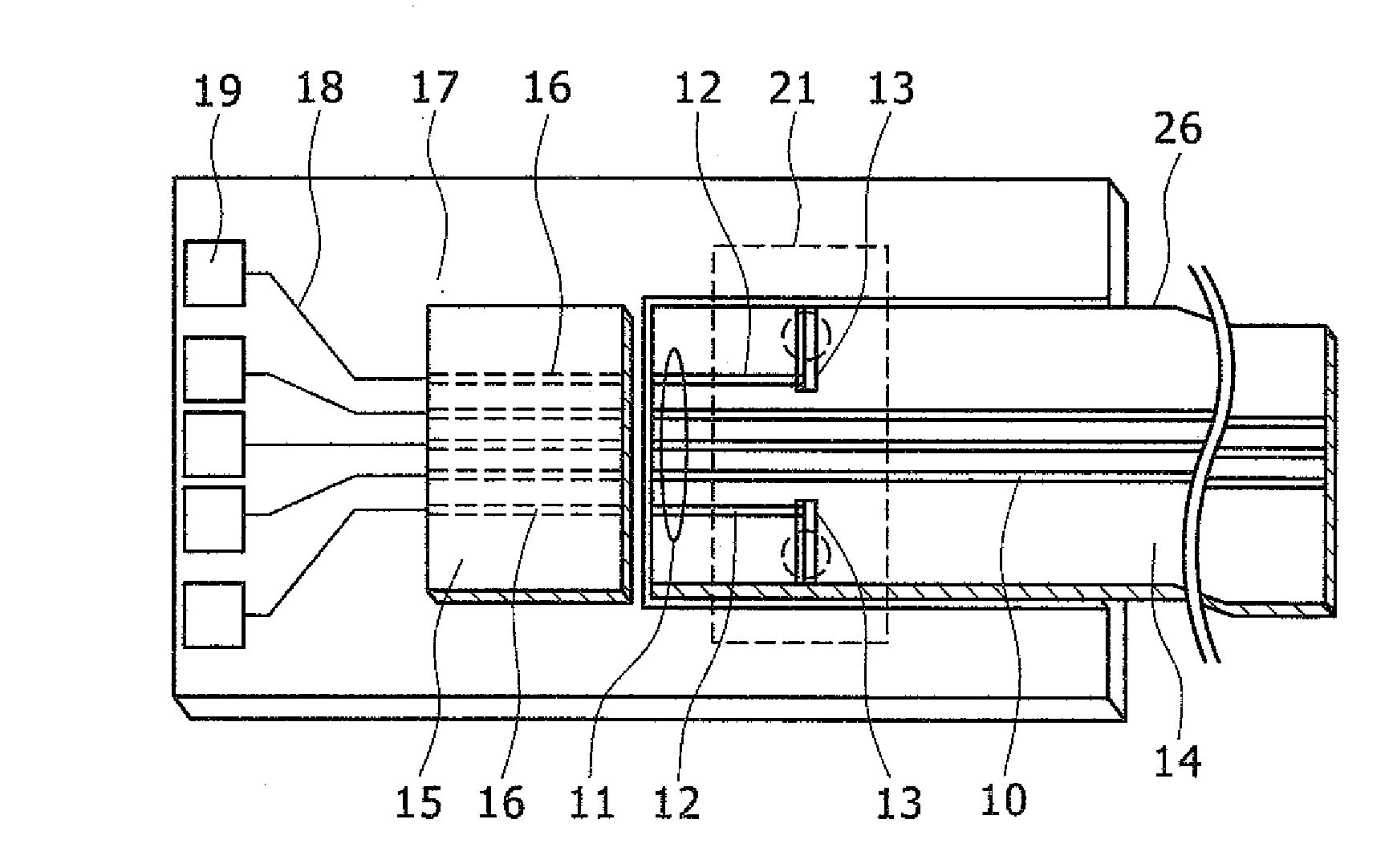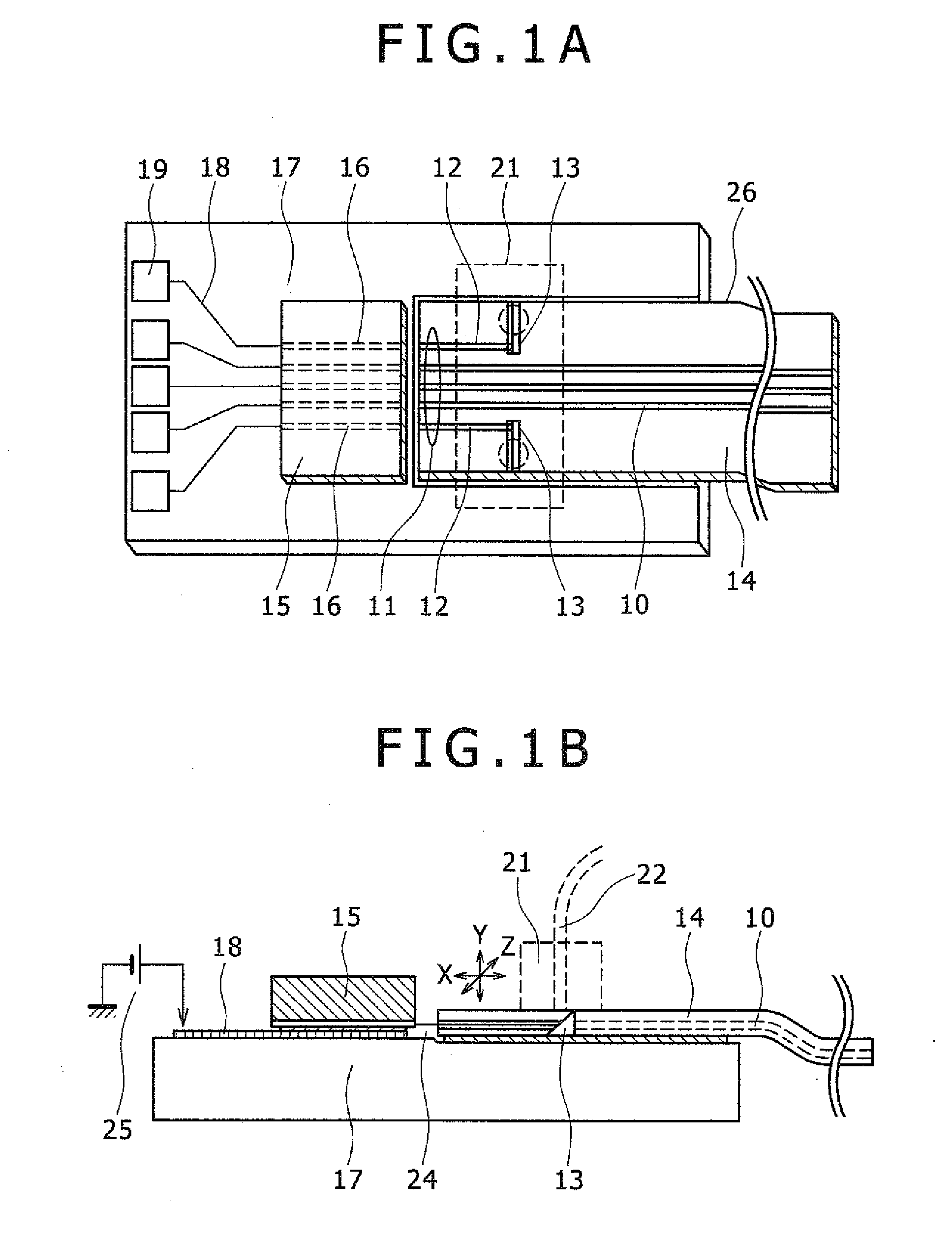Planar optical waveguide array module and method of fabricating the same
- Summary
- Abstract
- Description
- Claims
- Application Information
AI Technical Summary
Benefits of technology
Problems solved by technology
Method used
Image
Examples
embodiment 1
[0042]FIGS. 1A and 1B are a plan view and a sectional view, respectively, of a planar optical waveguide array module according to a first embodiment of the present invention. An optical element array 15 is disposed on a substrate 17. The optical element array 15 and an optical waveguide array 26 are optically connected on the substrate 17. The optical waveguide array 26 includes optical waveguide channels 12 which are the outermost ones on both sides of optical waveguide array channels 11 and each of which is provided with a mirror structure for light redirection 13. The planar optical waveguide array module is fabricated through steps outlined as follows: with the optical element array 15 driven by a bias 25 applied thereto, the optical waveguide array 26 is brought near the optical element array 15; the optical axes of the optical waveguide array channels 11 and the optical element array 15 are aligned while monitoring optical signals 24 outputted from the outermost optical wavegu...
embodiment 2
[0050]FIGS. 3A and 3B are a plan view and a sectional view, respectively, of a planar optical waveguide array module, including a surface light-emitting diode array, according to a second embodiment of the present invention. In this embodiment, a laser element array 40 mounted on a substrate 17 is a surface light-emitting diode array which emits light in a vertical direction to the element surface. To fabricate the planar optical waveguide array module according to the second embodiment, an optical waveguide array 26 is brought near the laser element array 40. The optical waveguide array 26 includes, in addition to a first mirror structure 13 for light redirection provided for each of the outermost optical waveguide channels 12 on both sides of optical waveguide array channels, a second mirror structure 42 formed in an end portion thereof. The subsequent fabrication steps are similar to those described with reference to FIGS. 2A to 2F. Namely, with the surface light-emitting diode a...
embodiment 3
[0051]FIG. 4 is a sectional view of a planar optical waveguide array module, including an edge illuminated type photodiode array, according to a third embodiment of the present invention. To fabricate the planar optical waveguide array module according to the third embodiment, an edge illuminated type photodiode array 50 is driven by applying a bias 25 (i.e. a reverse bias in this case) thereto via electrode pads 19 and electrical wirings 18. With the edge illuminated type photodiode array 50 thus driven, optical signals 24 outputted from optical fibers 22 are inputted to the outermost optical element channels on both sides of the edge illuminated type photodiode array 50 via the mirrors 13 for light redirection and the outermost optical waveguide channels on both sides of optical waveguide array channels. The optical axes of the edge illuminated type photodiode array 50 and the optical waveguide array 26 are then aligned while monitoring electrical signals 51 outputted, after photo...
PUM
 Login to View More
Login to View More Abstract
Description
Claims
Application Information
 Login to View More
Login to View More - R&D
- Intellectual Property
- Life Sciences
- Materials
- Tech Scout
- Unparalleled Data Quality
- Higher Quality Content
- 60% Fewer Hallucinations
Browse by: Latest US Patents, China's latest patents, Technical Efficacy Thesaurus, Application Domain, Technology Topic, Popular Technical Reports.
© 2025 PatSnap. All rights reserved.Legal|Privacy policy|Modern Slavery Act Transparency Statement|Sitemap|About US| Contact US: help@patsnap.com



